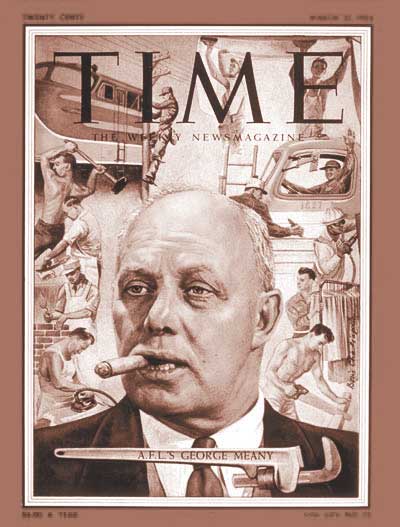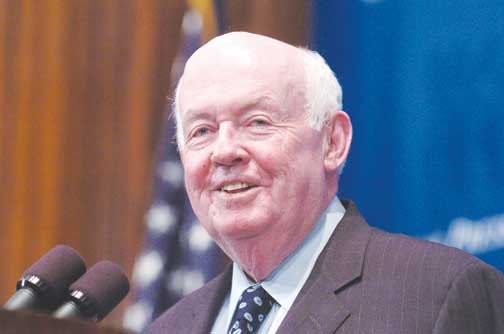


SERVICES
Tuesday September 2, 2009
Irish Americans And The Labor Movement
By John Mooney Labor Day is generally regarded as the unofficial end of summer - a day of picnics, barbecues, and perhaps one last trip to the beach. For school-age children, it usually signifies the end of summer recess and the commencement of another school year. What is sometime lost in the fun is that Labor Day is a celebration of the American worker. In fact, many of the strides made by workers were in large part due to the efforts of Irish Americans. Many believe that Peter McGuire, a member of the Brotherhood of Carpenters and Joiners and a co-founder of the American Federation of Labor (AFL), established the holiday. However, some historians credit Matthew Maguire, a machinist and the secretary of the Central Labor Union in New York, for proposing the holiday on Tuesday, September 5, 1882. Two years later, Labor Day was changed to the first Monday in September, where it has remained ever since. Irish Americans and the Labor MovementThe great influx of Irish immigrants following the Great Hunger settled predominantly in the industrial cities of the Northeast. The men often engaged in backbreaking jobs, while their families lived in crowded tenements and their children worked in sweatshops or even in mines. The labor movement grew from Irish leaders such as the Mollie Maguires, Terence Vincent Powderly, and Mary Harris "Mother" Jones. The Mollie MaguiresIrish immigrants often took mining jobs since they met discrimination in most other lines of work. In addition to enduring poor working conditions, coal miners lived in homes owned by the mining companies and were even compelled to buy groceries at company-owned stores. The Mollie Maguires first came to prominence in 1850s. They intimidated, physically harmed, and sometimes killed mine owners and bosses whom they felt exploited workers. To combat the violence, the mine owners hired the Pinkerton Detective Agency, which infiltrated the Irish mining community and collected evidence against the members of the Mollie Maguires. The evidence led to numerous arrests, and leaders, including Black Jack Kehoe, were hanged. From that point onward the Molly Maguires lost much of their influence. However, they succeeded in showing companies and bosses that when mistreated, workers would take matters into their own hands. Terence Vincent Powderly (1849-1924)Among the most noteworthy of all Irish-American labor leaders was Terence Vincent Powderly. Born in Carbondale, Pennsylvania, to Irish immigrant parents, he began working on the railroad at the age of 13. He joined several unions, including the Machinists' and Blacksmiths, for which he later served as president. A Fenian supporter, Powderly is best remembered for leading the Knights of Labor that had a goal of organizing skilled and unskilled workers into one big union for economic and social reform. The Knights became the largest and most influential force in the American labor movement during its heyday, and Powderly was given the title "Grand Master Workman," which he held from 1879 - 1893. While he helped organize unions for women and African Americans, Powderly, like other labor leaders of the era, opposed the arrival of Chinese workers because he believed they took jobs away from Americans and drove down wages. By 1886, the Knights of Labor reached a membership of one million, but then began to wane with the emergence of the American Federation of Labor (AFL). Mother Jones (1830-1930)Mary Harris "Mother" Jones was a courageous and successful union organizer who made a tremendous impact on the American labor movement.
Mother Jones was a tireless fighter for workers' causes Born in Cork in 1830, she emigrated to the U.S. at age five. She later married George Jones, an organizer for the Knights of Labor. In 1867, her husband and four children succumbed to yellow fever. From that point onward, she devoted herself to continuing her husband's work. Mother Jones took part in the 1882 coal strike in Hocking Valley, Ohio, and helped expand the United Mine Workers union. Over a 30-year span from 1891 until 1921, the self-proclaimed "hell raiser" led the miners in strikes in Pennsylvania, Virginia, West Virginia, Colorado, and Kansas. Her trademark tactic was to encourage miners' wives to step out of their traditional roles as housewives and persuade their husbands, including scab workers, to join unions. Mother Jones was a tireless fighter for workers' causes, especially the abolition of child labor, until she was nearly 100 years old. Today her memory is kept alive by Mother Jones magazine, a publication espousing "progressive" political values. George Meany (1894-1980)Born into an Irish Catholic family in New York, George Meany served as president of the American Federation of Labor (AFL) from 1952 to 1955, and, following its merger with the Congress of Industrial Organizations (CIO), led the combined AFL-CIO for the next quarter century. Meany's father, Michael, was president of the Bronx local of the United Association of Plumbers and Pipe Fitters. Young George joined the union as an apprentice at the age of 16 and worked as a plumber. In 1920, he was elected as the youngest member of the local union's executive board. He was active in both the New York City Central Labor Council and the New York State Federation of Labor, for which he became president in 1934. Meany built a powerful political organization and supported the reelection of President Franklin Roosevelt in 1936. He also led a successful strike for fair wages of craftsmen working on the public works projects of the New Deal. Meany was elected secretary-treasurer of the AFL in 1939 and was involved in the War Labor Board, which spurred union growth during WWII. He insisted on the inclusion of workers' rights in the postwar Marshall Plan and used his considerable clout to help elect President Harry Truman in 1948. In 1952, Meany became president of the AFL and then forged the merger with the CIO. His election as the first president of the combined labor union in 1955 was unanimous. Meany made the union a powerful political influence, particularly during the turbulent 1960s. He backed the civil rights movement, insisted that the historic 1964 Civil Rights Act call for an end to workplace discrimination, and supported the creation of the Medicare system in 1965. George Meany viewed the AFL-CIO as the only organization that spoke for the common man. During his 25 years at the union helm, Meany was a strong voice for workers rights and civil rights in America and around the world. He died in 1980, not long after stepping down as the AFL-CIO leader. His legacy includes the establishment of the National Labor College in Silver Springs, Maryland. John Sweeney (1934 - )The president of the AFL-CIO since 1995, John Sweeney was born in the Bronx in 1934, the son of Irish immigrants.
John Sweeney, the president of the AFL-CIO since 1995 He attended Cardinal Hayes High School and Iona College, where he graduated with a degree in economics. To pay for his tuition, Sweeney worked as a grave digger. In his early years, he attended numerous union meetings with his father, which began his life-long commitment to the American labor movement. Sweeney began his labor career working with the Ladies Garment Workers Union. He later served as president of the Service Employees International Union (SEIU) president from 1980-1995. Under his leadership, membership grew from 625,000 to more than one million - the first AFL-CIO union to reach that mark in two decades. He has helped organize office, maintenance, and health care workers and led mergers with other unions, notably the National Association of Government Employees. Since taking over the reigns of the AFL-CIO, Sweeney has strengthened organizing efforts and encouraged increased political activities. He has spearheaded outreach to women, people of color, immigrants and students. His numerous recruitment initiatives include a summer program utilizing college-age activists and the creation of "rapid response" teams that mobilize when labor disputes arise. He also created a Corporate Affairs Department that compiles statistics used in collective bargaining and also deals with labor-management partnerships, pensions, and investment issues. Sweeney has co-authored two books, including America Needs a Raise: Fighting for Economic Security and Social Justice. "Irish leadership in labor is a constant in an ever-changing world," said attorney John C. Dearie, who has worked with union leadership dating back to his 20 years in the New York State Assembly. "This is particularly true with people like John Sweeney, the number one labor leader in the country, Denis Hughes, the president of the NY State AFL-CIO, and Ed Molloy, the president of the Building Trades Council." Because they came to America to escape adverse conditions and seek a better life, the Irish were natural leaders to fight workplace hardships and corrupt bosses during the Industrial Age and throughout the 20th century. It can be easily argued that the labor movement in America would never have been as successful without the support Irish immigrants and their descendants at national and local levels. So as you enjoy Labor Day weekend, take pride that the contributions of Irish Americans provided an extra summer holiday and better lives for working people. |
CURRENT ISSUE

RECENT ISSUES


SYNDICATE
[What is this?]
POWERED BY

HOSTED BY

Terms of Service | Privacy Policy
Website Design By C3I








